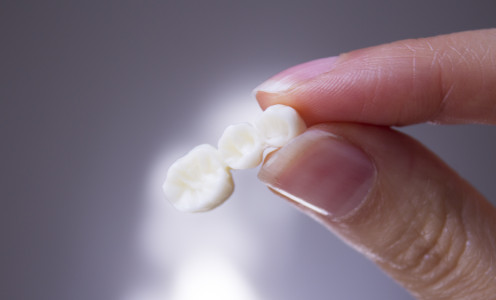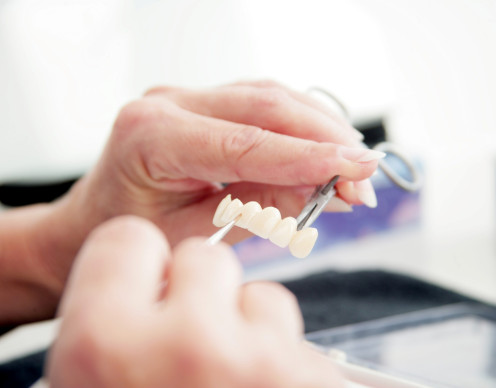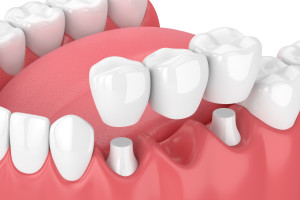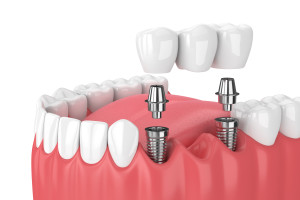Dental Bridges – Randolph, NJ
Bid Farewell to the Gap in Your Grin
Even having just one missing tooth can prove challenging, but what if you’re missing several teeth in a row? Needless to say, you’ll struggle to speak clearly, chew properly, and smile confidently. Fortunately, teeth can be replaced – and when it comes to filling in a gap left by multiple teeth, there are few solutions as effective as a dental bridge. Continue reading to learn a little more about dental bridges, or feel free to call our office for more information or to schedule an appointment to begin restoring your smile!
Why Choose Randolph Dental Care for a Dental Bridge?
- Proudly Family-Owned & Operated Dental Practice
- Insurance-Friendly & Flexible Financing Options Available
- Full Service Dental Implant Placement Under One Roof
What Is a Dental Bridge?

Dental bridges are a type of restoration that does exactly what the name implies; they “bridge” the gap left by several missing teeth in a row. This tried-and-true form of tooth replacement relies on either dental crowns or dental implants to secure a set of replacement teeth. Since the materials used are both durable and natural-looking, modern bridges can easily fill gaps left by missing teeth while also refreshing a patient’s overall oral functionality.
Types of Dental Bridges

All dental bridges serve the same purpose, but they are highly customizable since every patient experiences tooth loss differently. That said, we won’t know which type is better for your situation until we’ve had the chance to examine your smile. However, once we’ve confirmed that a bridge would be a good solution for your tooth loss, we’ll review the different types that we offer here at our Randolph office:
Traditional Dental Bridge

A traditional bridge can be used to replace a single missing tooth or several missing teeth in a row. First, two dental crowns can be placed on the teeth adjacent to the gap on both sides; keep in mind that this does require those teeth to be healthy. From there, a set of pontics, or replacement teeth, is used to fill in the gap.
Implant Bridge

An implant bridge takes all the practical benefits that a traditional bridge has to offer and combines them with the life-changing advantages that are associated with dental implants, including further bone loss prevention. Dental implant posts are strategically placed beneath the gumline, which, once healed, will fully support the dental bridge.
The Benefits of Getting a Dental Bridge

When you replace your missing teeth with a dental bridge, you’re drastically improving your quality of life and gaining access to numerous benefits, including:
- You’ll be able to eat and speak with ease since the bridge replaces teeth in terms of appearance and functionality.
- No one will be able to tell you’ve had dental work done, since bridges are designed to mimic your original teeth and look as natural as possible.
- Dental bridges are designed to last for 15+ years, or longer when combined with dental implants, assuming a patient can maintain excellent oral hygiene.
- If you opt for an implant bridge, your dental implant posts will prevent further bone resorption and help you to retain a more youthful appearance and fuller facial structure.
Dental Bridges FAQs
Is Getting a Dental Bridge Painful?
Whatever you may have thought, getting a dental bridge doesn’t hurt. The process is painless when performed by qualified dentists like our own.
A dental team will always numb your mouth before “prepping” your teeth for a bridge. In particular, they’ll apply a topical anesthetic on the treatment site to ensure it won’t ache. That means your smile shouldn’t hurt while it’s being prepared for your new restorations. At most, you’ll only feel slight pressure as the dentist and their team work.
(Notably, patients can also receive sedation during their bridge treatment. This option ensures you’ll remain calm and relaxed while your teeth are prepared.)
Is a Partial Denture the Same as a Bridge?
No, a partial denture isn’t the same thing as a dental bridge. It’s a distinct oral device with its own set of traits and qualities.
The main difference between these two restorations is removability. A partial denture can be taken out at will, but a dental bridge should remain in place for many years. The latter is thus a “fixed” restoration that can only be removed safely by a qualified dentist.
At the same time, the devices differ in what they replace. Dental bridges only restore consecutive missing teeth, “bridging” the gap between your remaining pearly whites. A partial denture can use metal clips or clasps to restore areas throughout your grin, whether they were adjacent or not.
Can Dental Bridges Be Whitened?
Sadly, dental bridges can’t be whitened like natural teeth can. Their design prevents them from being “brightened up” through dental work.
The issue comes down to how teeth whitening works. This treatment removes stains with a bleaching gel, which penetrates the pores in your enamel to brighten your smile. However, dental bridges don’t have such pores; therefore, whitening gel cannot affect them.
Of course, savvy patients can work around this hurdle. The best option is to whiten your teeth before having a dental bridge placed. In doing so, you’d ensure your fully restored smile has the same shade throughout.
Do Dental Bridges Feel Natural?
Your dental bridge should feel natural within a few days of its placement. By that point, it won’t draw your attention with odd or unwanted sensations.
Remember, dental bridges are made from durable materials. They can withstand everyday chewing and biting forces as easily as tooth enamel can. As such, eating with a bridge shouldn’t feel strange to you.
Note also that every dental bridge is custom-made for its patient. To ensure it fits your mouth snugly and smoothly, lab workers will design it based on impressions of your teeth. Your final bridge shouldn’t feel awkward or even noticeable once placed, as it’ll “match up” with your smile perfectly.









